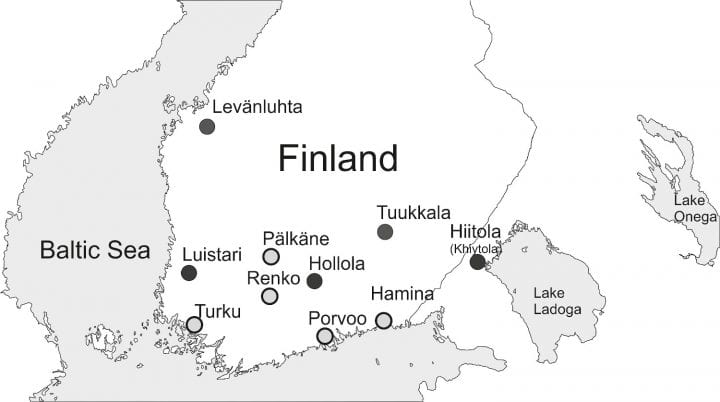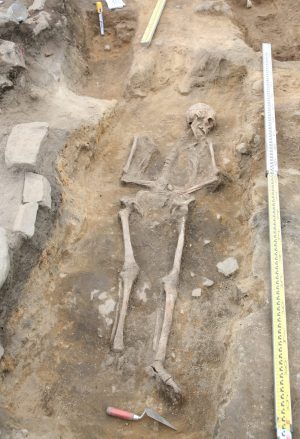Early DNA lineages from Finland shed light on the diverse origins of the contemporary population (Press release 15.11.2019)
A new genetic study carried out at the University of Helsinki and the University of Turku demonstrates that, at the end of the Iron Age, Finland was inhabited by separate and differing populations, all of them influencing the gene pool of modern Finns. The study is so far the most extensive investigation of the ancient DNA of people inhabiting the region of Finland.
In the study, genes were investigated from archaeological bone samples of more than one hundred individuals who lived between the 4th and 19th centuries AD. Most of the samples originated in the Iron Age and the Middle Ages. Mitochondrial DNA (mtDNA), which is passed down by mothers to all of their offspring, was extracted from the individuals, thus uncovering the population history of women.
Based on the findings, the people who inhabited Finland in the Iron Age (approximately 300–1300 AD) and the Middle Ages (approximately 1200–1500 AD) shared mitochondrial lineages with today’s Finns. However, significant differences were seen in the genome of individuals buried in different burial sites in the Iron Age in particular. mtDNA lineages typical of Stone Age hunter-gatherers were common among those buried in Luistari, Eura (southwest Finland), and Kirkkailanmäki, Hollola (southern Finland). In Kylälahti, Hiitola (Republic of Karelia, Russia) and Tuukkala, Mikkeli (eastern Finland), the most common findings were lineages characteristic of ancient European farmer populations. The fifth Iron Age burial site included in the study is located in Levänluhta, western Finland. Many of the individuals buried there represented mtDNA lineages associated with the modern Sámi.
“All of the above originally independent lineages remain common in Finland to this day. This indicates that the studied Iron Age populations have had an impact on the gene pool of contemporary Finns,” says doctoral student Sanni Översti from the Faculty of Biological and Environmental Sciences, University of Helsinki.
The researchers posit that the differences found in the Iron Age populations of western and eastern Finland are opposite to those found in today’s Finns: the lineages associated with ancient farmers were more common in the east, while the lineages inherited from hunter-gatherers were more prevalent in the west. Farmer populations arriving in Finland not only from the west and south but also from the east provides a potential explanation for this.

Map: The Iron Age and the medieval burial sites investigated in the study include Levänluhta in Isokyrö, Luistari in Eura, Kirkkailanmäki in Hollola, Kalmistomäki in Kylälahti, Hiitola, and Tuukkala in Mikkeli (marked in the map with dark grey colouring). Burial sites from recorded history and the modern period investigated in the study include the Church of St Michael in Pälkäne, the Porvoo Cathedral, the Church of St Jacob in Renko, the Julin’s site in Turku and the Ryazan regimental Church in Hamina (marked with a light grey colouring). The image has been edited on the basis of the original (CC BY 4.0 licence).
The study was carried out under SUGRIGE, a project focused on Finno-Ugric ancient genes, at the University of Helsinki and the University of Turku.
The study was funded, among others, by the Jane and Aatos Erkko Foundation, the Kone Foundation, the Finnish Cultural Foundation, the Emil Aaltonen Foundation and the Academy of Finland.
Information about the publication
Sanni Översti, Kerttu Majander, Elina Salmela, Kati Salo, Laura Arppe, Stanislav Belskiy, Heli Etu-Sihvola, Ville Laakso, Esa Mikkola, Saskia Pfrengle, Mikko Putkonen, Jussi-Pekka Taavitsainen, Katja Vuoristo, Anna Wessman, Antti Sajantila, Markku Oinonen, Wolfgang Haak, Verena J. Schuenemann, Johannes Krause, Jukka U. Palo, Päivi Onkamo. Human mitochondrial DNA lineages in Iron-Age Fennoscandia suggest incipient admixture and eastern introduction of farming-related maternal ancestry (2019). Scientific Reports: www.nature.com/articles/s41598-019-51045-8
Further information
- Sanni Översti, doctoral student, University of Helsinki, phone: +358 45 263 0632, email: sanni.oversti(at)helsinki.fi
- Päivi Onkamo, professor and group leader for the SUGRIGE project, University of Turku and University of Helsinki, phone: +358 50 4643379 or +358 40 578 9189, email: paivi.onkamo(at)utu.fi
Research findings previously published by the SUGRIGE project:
Ancient DNA shows the Sámi and Finns share identical Siberian genes (release from 27 November 2018)
Medieval burial site of Kalmistomäki in Kylälahti, Hiitola in Russia. Image: Stanislav Belskiy.
